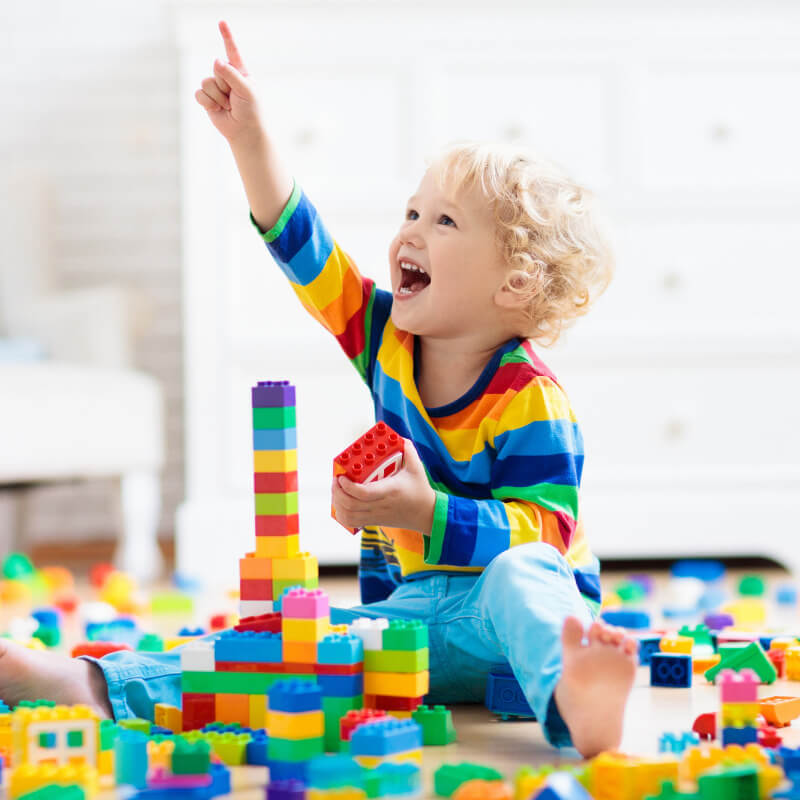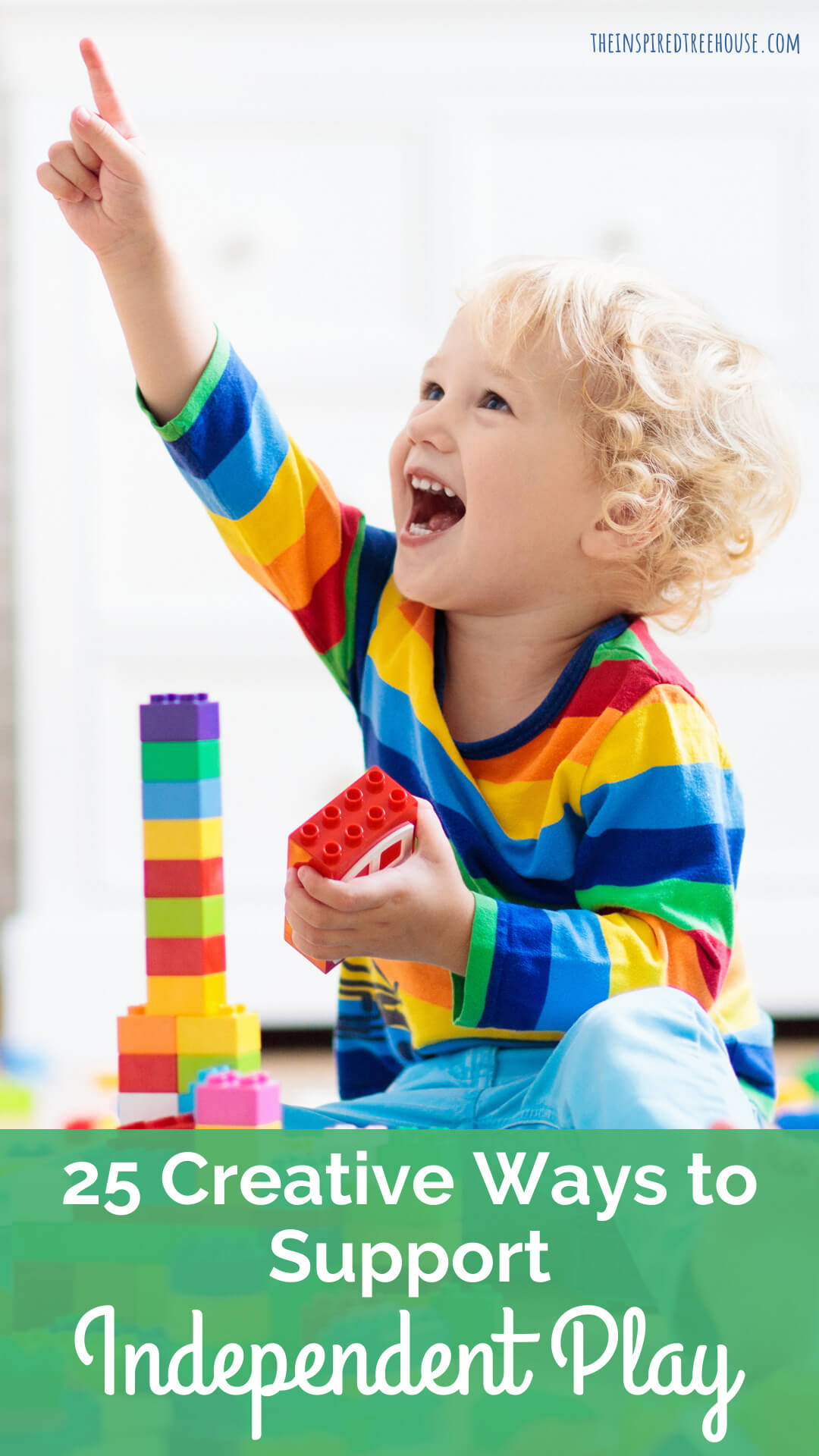Ready to find out how to teach your child to play independently? These 25 ideas will spark creativity, independence, and fun!
*This post contains affiliate links. Read more.
If you struggle to truly enjoy engaging in imaginative play with your kids, trust us, you are not alone. It can be hard (and exhausting) to get down on the floor and pretend to be pirates or play dolls with your little one. And while we know that engagement and pretend play are crucial aspects of child development for so many reasons, we also like to emphasize the importance of independent unstructured play for kids.
It’s so important for kids to be able to create their own playful means of entertainment through creativity and problem solving! And promoting this skill may mean that you can actually check your email for 15 minutes without a thousand interruptions!
Practicing independent play regularly is important when it comes to teaching young children how to get in the habit of entertaining themselves. Building solo play into your daily routines can help build kids’ stamina and attention span for playing on their own.
Why is independent play so important?
It builds confidence
When kids play on their own, they learn that they don’t need to rely on others to create fun for them. The more they do it, the more self-reliant they become!
It builds creativity and imagination
When kids play independently, they can be less inhibited with their play. they don’t have to worry about what anyone else thinks and this can lead to new ideas.
It’s great for self-regulation
When kids play independently, they naturally gravitate toward play activities that can help them regulate their brains and bodies. Some kids may gravitate toward quieter play activities, while others may need more active play to maintain regulation.
It can help limit screen time
When kids are able to entertain themselves with fun play activities at home, you may not have to rely on movies, tv shows, and video games to keep their attention when you need a break.
It fosters problem-solving skills
Independent play supports kids’ ability to solve their own problems without the help of a parent or other adult. Again, this promotes confidence and creativity!
It gives caregivers a much needed break!
Many parents and caregivers beat themselves up for not engaging and playing with their children every minute of the day. But the truth is, no one can (or should) play with their kids all the time! We all need breaks throughout the day to relax and recharge – and so do our kids.
How to encourage independent play
So how can you promote independent play for your child at home or even with the kids in your classroom or therapy room? One idea is to combine different toys or materials that don’t normally go together. This approach often sparks kids’ interest, and once you introduce the materials and provide some ideas, kids can take over and play on their own!
This is also a great way to refresh all the familiar toys that kids are bored with!
Here are some of our favorite ideas to try during your child’s next independent play time…
Play dough and puzzles
Use inset puzzles with peg handles as stamps to create shapes in the play dough!
Markers or crayons, paper, and blocks
Kids can use markers to trace around the different block shapes and then match the blocks to the correct outlines.
Any toy with water, soap, scrub brushes, and spray bottles
Create a car wash or use toy animals for bath time at the zoo!
Play dough with blocks and Legos
Different shaped blocks and legos make interesting prints on play dough.
Markers, paper, and toy animals and action figures
Kids can draw houses, cages, sidewalks, and other fun designs for their toys.
Markers and cars
Kids can draw roads, parking spaces, towns, houses, and other obstacles for their cars to drive through.
Mr. Potato Head and play dough
Use the different pieces to create faces in the play dough instead of on Mr. Potato Head’s head.
Perfection game and play dough
If you have the game of Perfection in your game closet, pull out the pieces to use as stamps with play dough!
Trains, tracks and magna tiles or blocks
Have kids build tunnels and towns for their toy trains to drive through.
Plastic toy dishes and play dough
These are the perfect props for a pretend restaurant set-up! Add some paper and pens so they can take orders.
Hexbugs and Magnatiles or Legos
We love building race tracks and cages for our Hexbugs to run around in using Magnatiles or Legos
Play tunnel with cars
Kids love crawling through these fabric tunnels and it’s even more fun when they can take a toy car along for the ride!
Tape and toy animals or action figures
Play a game of “rescue”! Wrap toys or action figures up with tape and leave them out for your child to find. Tell them that a bad guy has trapped their toys and they need to be saved!
Tape and cars
Have kids use tape to create roads and other obstacles for their cars.
Markers and puzzles
Kids can trace around the outline of the puzzle pieces to create interesting shapes on their paper.
Any toy with a bin full of dry beans or dry rice
Add almost any toy to a sensory bin, and you can almost guarantee some uninterrupted independent play! Check out these ideas for other additions to your sensory bin!
Magnatiles and action figures or toy animals
Kids can build houses for their action figures or a zoo with cages for their toy animals.
Toy cars and small empty cardboard boxes
Try these cardboard blocks or just use shoe boxes and other empty containers so kids can create bridges, buildings, parking garages, and more!
Stickers, large paper, and cars
Kids will have a blast making obstacle courses for their cars by placing stickers on the paper and then navigating around them!
Toy cars and Squigz
Squigz are another favorite toy of ours and another great way to create obstacles for cars on the floor.
Play dough and balls with different textures
Kids can roll each ball onto their play dough like a rolling pin to see the different prints they make.
Rubber stamps and play dough
This is one of our favorite ways to use rubber stamps! It’s great for building grasping skills and hand strength and kids love seeing the different shapes the stamps can create in the play dough.
Blocks and Legos with cars
Build roads, obstacles, buildings, tunnels, and bridges with the blocks and Legos for the cars to drive through.
Couch cushions and stuffed animals
This is a great way to encourage some heavy work and overall physical activity for kids. Have them use the cushions to create houses, tunnels, cages, and hideouts for their animal friends!
Toy tools and cars
Try pairing toy tools with small toy cars or even ride-on cars from the garage. Kids will love pretending to be the mechanic fixing all of the broken parts!
We hope these ideas bring some fun inspiration to your home, classroom, or therapy room! All of these ideas are great for independent play, for breathing new life into old toys that kids have lost interest in, and for building motor skills and supporting other areas of development!


Latest posts by Claire Heffron (see all)
- Cute Zipper Bags for Therapists - April 18, 2024
- Fairy Tale Games and Toys - April 12, 2024
- The Best Emotional Regulation Books for Kids - April 8, 2024

